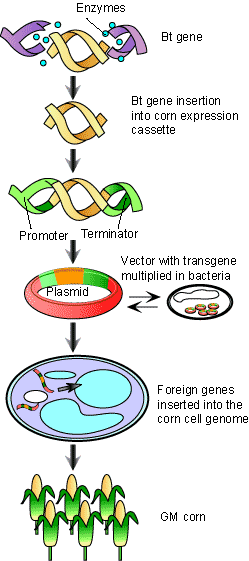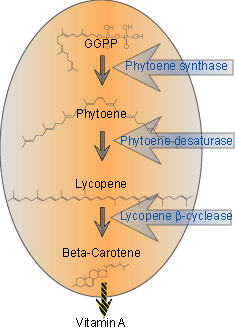GENETICALLY MODIFIED FOODS
(August 2004)
Generally, this term refers to food crops that have been altered using a variety of molecular biology techniques in order to provide them with either new or enhanced characteristics. Examples of such enhancements of modifications are herbicide tolerance, pesticide resistance, greater nutritional content or increased tolerance of cold temperatures. Genetically modified organisms (GMOs) can also be referred to as transgenic organisms. Transgenic simply means that the organism’s genes come from more than one source.
The idea of enhancing desired traits in food crops is not new. Upon domestication of many plants, farmers used the process of artificial selection to grow plants with desired qualities. However this method can be time consuming and it is very difficult to introduce new traits into a specific population. In contrast, using genetic engineering, scientists can take the gene that controls the trait from one organism and insert it into another organism that does not have the gene. This creates an organism with the desired characteristic quickly and easily. A common example of genetic engineering is the insertion of Bacillus thuringiensis genes into corn to make Bt corn. Bacillus thuringiensis is a bacterium that naturally produces a protein that is lethal to insect larvae. By transferring the genes that encode this protein into corn, scientists have created a type of corn that produces its own pesticides, making it resistant to insects such as the European corn borer.
Transferring the gene
Taking a gene from one organism and inserting it into another is essentially a process of cutting the gene which codes for the trait of interest from the foreign organism and pasting this gene into the genome of the organism that you want to alter.
Let us use the insertion of B. thuringiensis genes into corn as an example. In order to cut out the gene of interest in the bacteria, its total DNA is isolated. Special enzymes, called restriction endonucleases, act as scissors to cut out the desired gene. These enzymes are sensitive to the DNA sequence and will only cut DNA at specific spots. There are many different enzymes that cut in different places, so the enzyme used depends on the sequence of DNA surrounding the desired gene.
Once the gene is cut out, scientists must make an “expression cassette.” This consists of additional DNA surrounding the gene so that the corn cell knows where the gene of interest begins and ends. The part that tells the corn cell where the gene begins is called the promoter and the end, the terminator. Once the expression cassette has been made, it is inserted into a plasmid. The plasmid is a parasitic circle of DNA present in bacteria. By putting the cassette into a plasmid, millions of copies of it can be made. These copies are then introduced into the host cell and get inserted into the genome. Cells which have successfully incorporated the foreign gene into their genome are then expanded in cell culture and used to generate new plants.

The ethics of GM Foods
GM foods have been the subject of much controversy. Advocates feel that GM foods will help provide food to the world’s continually expanding population. Since the number of people on earth keeps increasing (over 6 billion, and expected to double within 50 years), and the amount of land suitable for farming remains constant, more food must be grown in the same amount of space. Genetic engineering can make plants that will give farmers better yields through several different methods.
Crops can be harmed or destroyed by many different factors. Insects, weeds, disease, cold temperatures and drought can all adversely affect plants resulting in lower yields for the farmer. Genetic engineering techniques can be used to introduce genes, creating plants that are resistant or tolerant to these factors. Bt corn is an example of the introduction of a pest resistance gene. Monsanto has created strains of soybeans, corn, canola and cotton that are resistant to the weed-killer Roundup®. The weed-killer can be sprayed over the entire crop, killing all plants except the transgenic crop intended to be grown. Scientists have also taken a gene from a cold-water fish and introduced it into potatoes to protect the seedlings against sudden frost. These methods all create plants that are more likely to survive and be healthy, thereby increasing the production of farmer’s fields.
Genetic modification can also be used to change the properties of the crop, adding nutrients, making them taste better, or reducing the growing time. A good example of adding nutrients to food is the development of “golden” rice. Many countries in the world rely on rice as their primary food source. Unfortunately, rice is missing many essential vitamins and minerals, so people whose diet is based on rice are often malnourished. One of the most severe consequences of this is blindness caused by vitamin A deficiency. Researchers at the Swiss Federal Institute of Technology Institute for Plant Sciences genetically engineered rice, making it high in vitamin A. The group hoped to distribute the rice for free to any third world country requesting it.
Golden rice is a controversial subject in its own right. Its development was a breakthrough for biotechnology as it was the first time 3 genes were introduced simultaneously (generally, only one gene is transferred at a time). Mammals make vitamin A from beta-carotene, which is not found in polished white rice. A precursor to beta-carotene (geranyl geranyl diphosphate, or GGPP) is present, but three additional chemical reactions must be carried out to transform GGPP into beta-carotene. The gene transfer was successful, resulting in rice that is high in beta-carotene and is actually yellow coloured. On the surface, this seems like the solution to vitamin A deficiency.

Sounds great, right? GM foods can be grown easily, withstanding cold or drought, without spraying for pests or weeds. Not only that, but the food can be made more nutritious. So what’s the problem? Why so much controversy?
Opponents of genetic modification have many criticisms against this new technology. First of all there are multiple environmental concerns. GM foods can cause harm to other organisms unintentionally. For example, a study published in Nature on Bt corn found that the pollen caused high mortality rates in monarch butterfly caterpillars, even though the caterpillars don’t eat corn [1]. If the Bt corn pollen is blown onto neighbouring milkweed plants (the caterpillars food source) the caterpillars could eat the pollen and die. The results of this study are under debate, since the experiments were not done in the field, but in a laboratory, and new studies suggest that the original may be flawed. Researchers at the University of Guelph performed a study and found that under natural conditions, Bt corn does not pose a risk to the monarch butterfly [2].
Similarly, if pollen is blown onto neighbouring plants, the plants could crossbreed and the introduced gene could be transferred to non-target plants. This is a concern if a herbicide resistant crop were to breed with a weed and transfer the herbicide resistance gene. This would create a weed that is unharmed by the chemicals used to kill it.
Monsanto has patented their Roundup Ready seeds, and farmers wishing to use them must purchase a license from the company. This can lead to trouble for farmers who don’t use the Monsanto seeds. Perry Schmeiser is a canola farmer in western Canada who has never bought seeds from Monsanto. In 1998 he was sued by Monsanto since they discovered Roundup Ready canola in his field. Schmeiser claims that the seed was blown in from neighbouring fields, but Monsanto believes he obtained it illegally or stole it. Regardless of how it was obtained, Monsanto felt this was patent infringement and took Schmeiser to court in June of 2000. This court battle captured the interest of farmers around the world, because even if they did not intend or even want to have patented seeds in their fields, they could be sued. The judge ruled in favour of Monsanto and stated that it didn’t matter how the seed got into Schmeiser’s field. Whether it was blown in, cross-pollinated by birds, bees or animals, fell off farmer’s trucks or migrated from a neighbour’s field, it is still patent infringement, and the plants were to become the property of Monsanto. All of Schmeiser’s profits from 1998 were awarded to Monsanto since there was a probability of having the genetically altered seeds throughout his fields.
Insect pests may also become resistant to the toxins produced by GM crops like Bt corn. It is now known that some bacteria are becoming antibiotic resistant (so-called “superbugs”) making it difficult to treat diseases such as tuberculosis. Likewise, opponents of GMOs believe that insects could become pesticide resistant making them difficult to control in the future.
Along with environmental concerns, there are also worries about the effects that GM foods can have on humans. There are concerns that introducing a new gene into a food could cause an allergic reaction in some people (for example, if the gene came from a nut). Most scientists believe that other than allergic reactions, GM foods do not pose a threat to human health, however as with all new products, no long-term studies have been performed.
How are genetically modified foods regulated in Canada?
The Canadian Food Inspection Agency (CFIA) is responsible for the control of GM foods in Canada. The CFIA has strict criteria that must be met before a GM food can be marketed. These include: how the food crop was developed, including the molecular biological data which characterizes the genetic change; composition of the novel food compared to non-modified counterpart foods; nutritional information for the novel food compared to non-modified counterparts; potential for new toxins; and potential for causing an allergic reaction. Once the government is satisfied that requirements have been met, the food is approved for consumers. Right now, Canada has no mandatory labeling policy for GM foods, it is strictly on a volunteer basis, however mandatory labeling is required if the introduced gene poses an allergy risk (eg. if the gene introduced came from a nut) or if the food’s nutritional content has changed. A Canadian standard for labeling of biotechnology derived foods is being developed and is expected to be completed in the fall of 2002.
The CFIA has approved 51 “novel foods”, most of which are GM foods, including corn, (types resistant to corn borers and herbicides); canola, (varieties resistant to herbicides); potato (varieties resistant to Colorado potato beetles); tomato (varieties that ripen slowly); squash; soybean; sugarbeet; flax; and cottonseed oil.
References
1. Losey JE, Rayor LS, Carter ME. Transgenic pollen harms monarch larvae. Nature 399, 214 (1999).
2. Sears MK, Hellmich RL, Stanley-Horn DE, Oberhauser KS, Pleasants JM, Mattila HR, Siegfried BD, Dively GP. Impact of Bt corn pollen on monarch butterfly populations: A risk assessment. Proc Natl Acad Sci U S A. 2001 Oct 9;98(21):11937-42.
(Art by Jen Philpott)